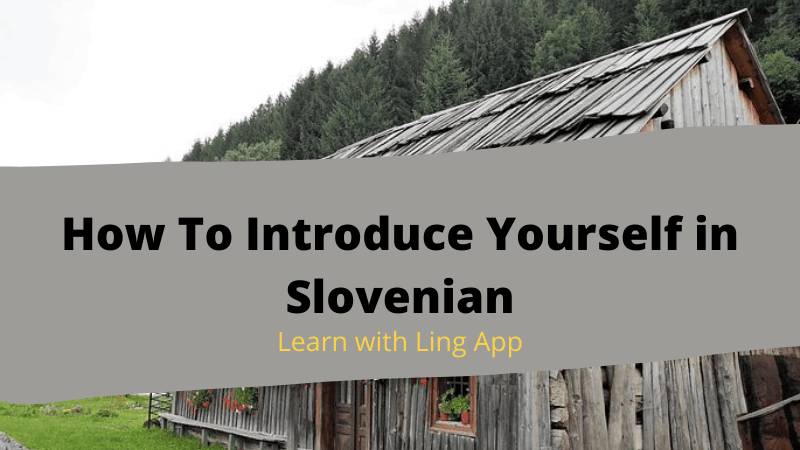Being a language enthusiast, do you know how to introduce yourself in Slovenian? If not, then this blog is perfect for you. In today’s post, we will walk you through several ways of introducing yourself in Slovenian based on different occasions and situations. So let’s get started.
The sentences for introducing oneself in Slovene depend upon various factors, including their gender and level of formality. Generally, four main categories can be formed to study this phenomenon: Male vs. Female and Formal vs. Informal. Let’s discuss more about this below.
How To Introduce Yourself In Slovenian

If you are new to the Slovenian culture, then allow us to tell you about some of how Slovenian people interact with each other. If the Slovenian people are in a formal/professional gathering, e.g., in schools, colleges, teachers, seniors, or the general public, they use formal speech.
Furthermore, formal speech is also used on the occasions when the Slovenians are talking to a person of high status or more age than them. According to their culture, a Slovenian child would (and should, according to their culture) use formal speech while addressing someone older than them.
Your Name
There are two main ways to tell your name in Slovenian. Using “Jaz sem” as well as “pišem se”. These are commonly used, but there are other ways too that we will explore. Let’s dive in!
Pišem Se
You often hear the people say, “Pišem se (name).” That might not make much sense to you since this word is a verb that means “write.” It is weird to literally translate the entire sentence because a sentence like “Pišem se Potisek” will be translated to “write it Potisek.”
However, it has an English equivalent, or close to its equivalent, “The surname is.” It should be used in a formal way only.
Jaz Sem
Jaz sem means “I am”. You can directly add your name afterward. For example, you could say “Jaz sem Paula” to say “I am Paula”. This is a relatively informal/casual way of telling someone your name.
It can be followed by both names but usually has the surname.
Moje Ime Je
Moje Ime je is the same as the previous one with one slight difference that this sentence is used in formal situations. For instance, if you are introducing yourself to the class or a department, you can say “Moje Ime je Smith” which would mean “My name is Smith”.
Moj Priimek Je
Moj prime je is used to tell someone about your surname. Usually, this is only told when someone asks for your surname. In other cases, the Slovenians would like to introduce themselves with their full names or first name in some cases.
Ime Mi Je
This is just a slightly tilted form of “Moje Ime je ” which also implies more or less the same meaning. Someone might say “Kako vam je ime?” to which you need to reply using all the abovementioned ways.
Your Age
Again, there are several ways of telling about your age, and some of those are “Star sem (number) let,” “Stara sem (number) let,” and “Imam (number) let.” You should know it’s your time to tell your age when someone asks, “Koliko ste stari?” Let’s get into how to use each.
Star Sem (Number) Let
“Star sem (number) let” is a formal way of telling someone your age. It literally translates to I am (number) years old. The number indicates your age.
Stara Sem (Number) Let
“Stara sem (number) let” is the same as the previous one, with the only difference being the use for gender. For a woman, the word stara is used instead of star. So if you are a girl/woman, then you should tell your age using “Stara sem (number) let.”
Imam (Number) Let
A rather casual way of telling about your age could be “Imam (number) let.” If you need a literal translation, this would mean “I have (number) years.” This is different from English, and as an English speaker, it might not even make any sense to you.
However, if you are a Spanish speaker, you can relate to this transition. “Tengo (number) años” in Spanish is its equivalent.
Your Address
Now let’s move on to some of the tricky concepts. After you have told about your name and age, you need to tell about where you are from or where you are residing. Let’s learn some of the most common and easy-to-learn expressions.
Fun fact: Did you know that even the places in Slovenian have genders? There are two ways to distinguish if a place is feminine or masculine. If the name of a place ends with an “e,” then you should get the idea that the place is feminine. However, if a place ends with the letter “a,” then the gender of the place is masculine.
Jaz Sem Iz
You can say Jaz Sem iz (country). You can learn about the neighboring countries of Slovene to practice telling your country in the Slovenian language.
This is an excellent way of telling someone about where you are from. It requires some conjugations, e.g., changing the ending a to e and any word with no “a” ending to “a.”
Živim V
You can also use “Živim v (country/city)” to mean “I am from.” This is another way of telling someone about your place.
Moj Naslov Je
Moj naslov je means “My address is (area)”. This is usually used for the residential address. You need to mention your street number, address, city, and country. The word “Naslov” is translated to “address” in English.
Your Profession
And finally, the domain that usually concludes the introduction is the profession. Different ways of telling about your profession are as follows:
Po Poklicu Sem/Moj Poklic Je
Po poklicu sem means “I am a — by occupation.” This is used in both formal and informal situations. Another way of saying that is Moj poklic je.
Wrapping Up

If you are learning Slovenian and liked this blog, you should also look at our other blogs. We have also uploaded Slovenian Blogs about colors in Slovenian and common Slovenian slang words. Start learning new languages in a fun way. If you are interested in getting free-spoken and written language lessons, then feel free to check out Ling App by Simya Solutions.
Happy Learning!



































































